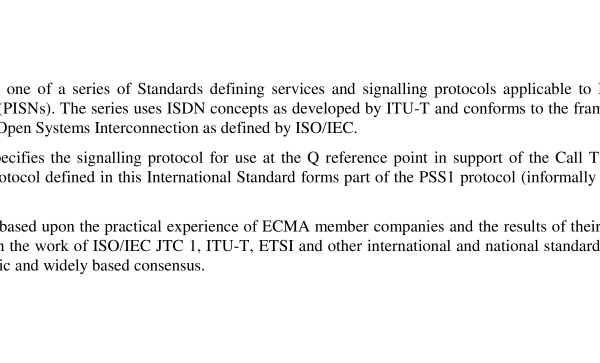ISO IEC 19460:2003 pdf download – Information technology — Telecommunications and information exchange between systems — Private Integrated Services Network — Inter-exchange signalling protocol — Single Step Call Transfer supplementary service.
1 Scope This International Standard specifies the signalling protocol for the support of the Single Step Call Transfer supplementary service (SS-SSCT) at the Q reference point between Private Integrated Network services eXchanges (PINXs) connected together within a Private Integrated Services Network (PISN). SS-SSCT is a supplementary service which enables a user, user A, to transform an existing call between user A and user B into a new call between user B and a user C whereby user A does not have a call established with user C prior to call transfer. The Q reference point is defined in ISO/IEC 11579-1. Service specifications are produced in three stages and according to the method specified in ETS 300 387. This International Standard contains the stage 3 specification for the Q reference point and satisfies the requirements identified by the stage 1 and stage 2 specifications in ISO/IEC 19459. The signalling protocol for SS-SSCT operates on top of the signalling protocol for basic circuit switched call control, as specified in ISO/IEC 11572, and uses certain aspects of the generic procedures for the control of supplementary services specified in ISO/IEC 11582. This International Standard also specifies additional signalling protocol requirements for the support of interactions at the Q reference point between Single Step Call Transfer and other supplementary services and ANFs. This International Standard is applicable to PINXs which can interconnect to form a PISN. 2 Conformance In order to conform to this International Standard, a PINX shall satisfy the requirements identified in the Protocol Implementation Conformance Statement (PICS) proforma in annex A. Conformance to this International Standard includes conforming to those clauses that specify protocol interactions between SS-SSCT and other supplementary services and ANFs for which signalling protocols at the Q reference point are supported in accordance with the stage 3 standards concerned.
6 Signalling protocol for the support of SS-SSCT 6.1 SS-SSCT description SS-SSCT is a supplementary service which enables a user, user A, to transform an existing call between user A and user B into a new call between user B and a user C whereby user A does not have a call established with user C prior to call transfer. This supplementary service is applicable to all basic services defined in ISO/IEC 11574. 6.2 SS-SSCT operational requirements 6.2.1 Provision/Withdrawal Provision and withdrawal shall be in accordance with 6.2.1 of ISO/IEC 19459. 6.2.2 Requirements on a Transferring PINX The basic call procedures specified in ISO/IEC 11572 shall be supported. Generic procedures for the call-related control of supplementary services, as specified in ISO/IEC 11582 for an End PINX, shall apply. 6.2.3 Requirements on a Rerouting PINX The basic call procedures specified in ISO/IEC 11572 shall be supported. Generic procedures for the call-related control of supplementary services, as specified in ISO/IEC 11582 for an End PINX, shall apply. 6.2.4 Requirements on a Transferred PINX The basic call procedures specified in ISO/IEC 11572 shall be supported. Generic procedures for the call-related control of supplementary services, as specified in ISO/IEC 11582 for an End PINX, shall apply. 6.2.5 Requirements on a Transferred-To PINX The basic call procedures specified in ISO/IEC 11572 shall be supported. Generic procedures for the call-related control of supplementary services, as specified in ISO/IEC 11582 for an End PINX, shall apply. 6.2.6 Requirements on a Transit PINX The basic call procedures specified in ISO/IEC 11572 shall be supported. Generic procedures for the call-related control of supplementary services, as specified in ISO/IEC 11582 for a Transit PINX, shall apply.
ISO IEC 19460:2003 pdf download – Information technology — Telecommunications and information exchange between systems — Private Integrated Services Network — Inter-exchange signalling protocol — Single Step Call Transfer supplementary service






